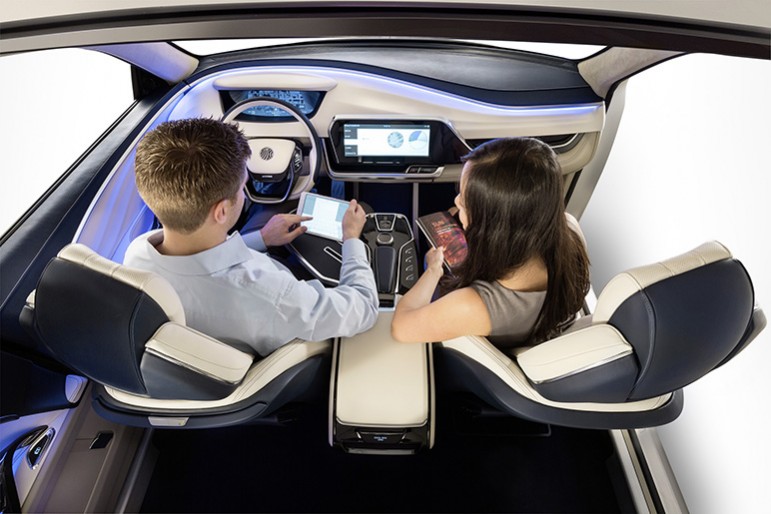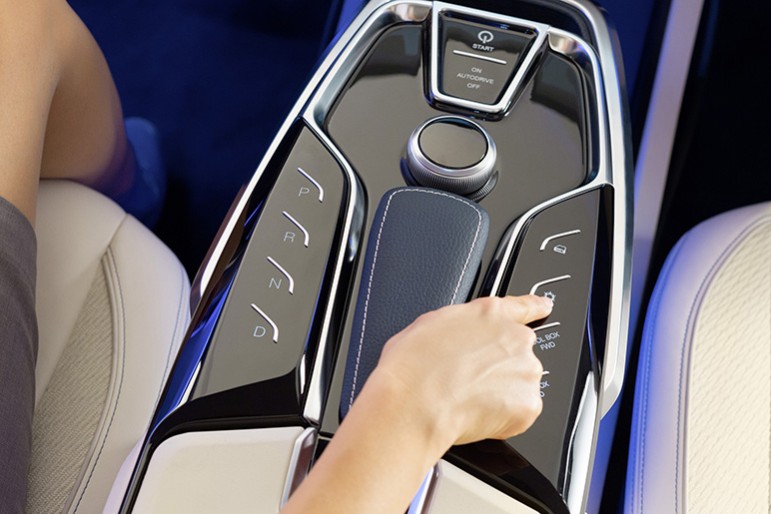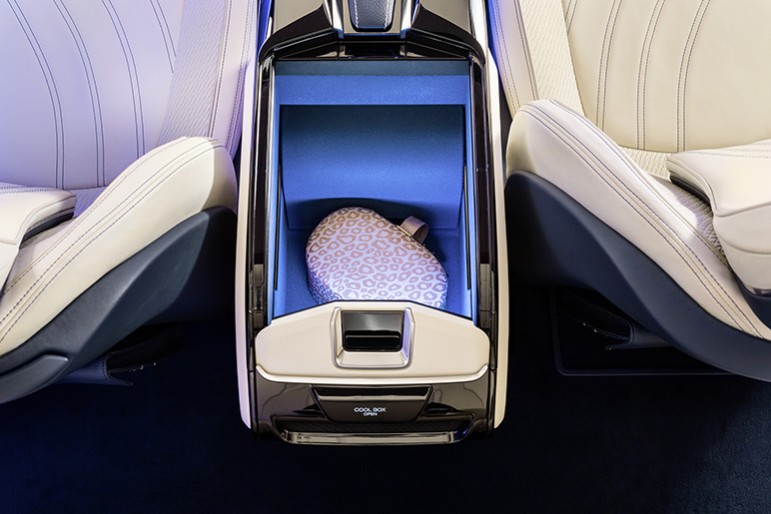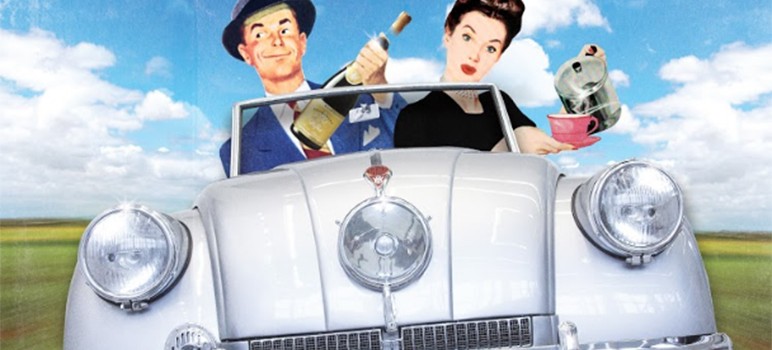After touring an exhibition put on by Yanfeng, the world’s largest auto interior company, I hailed an Uber driver who happened to be on his first day of work. Six fares in and loving it, he sparked up the customary chit-chat, asking what I’d been doing. I stuttered. I didn’t want to deflate his excitement. I’d just seen the future, and it didn’t include him.
Yanfeng’s showroom prototype sported a soon-to-be omnipresent feature that will replace virtually any vehicle service that requires an actual driver. But, more cheerily, it’ll also reduce traffic, pollution and death, plus save trillions of dollars. The revolutionary feature? A steering wheel that nestles into the dash during autonomous mode.
Sitting in the glitzy, leather-wrapped faux cockpit, I wondered if America—a land wedded to the lusty mythology of exploring the open road—could ever let automated driving overtake the manual method. Han Hendriks, a Yanfeng vice president with a crisp German accent, sighed and answered with the casual surety of a man easily in his four-thousandth rendition of hearing this question.
“Autonomous flying was introduced to the commercial airline market in the ’70s,” he says. “And without any exception, all the pilots said, ‘Never. I will always fly my plane.’ Today, all pilots fly autopilot. No exceptions. All of them. It's human nature, apparently.”
To Hendriks, anyone opposed to autonomy is thinking about it wrong. Bay Areans might love to wind through eucalyptus-lined mountain roads. But automated driving, at least the first wave, will take over navigation nobody wants to do—Highway 101-esque straightaways or traffic jams where the average American wastes somewhere between 38 to 81 hours every year.
“Sure you love driving in your [Porsche] 911 on Sunday,” Hendriks says. “But do you love driving when you’re in a traffic jam every morning? Every evening? That’s a different driving. I love driving, but I hate traffic.”
Automated driving wouldn’t just let people nap, work or do whatever in traffic. It would also drastically improve safety and reduce commute times. Intercommunicating cars could “platoon” in columns too tightly packed for humans to ever sustain—an arrangement that’s denser and more aerodynamic. This could end gas-guzzling, stop-start jams and spawn a ripple effect of positives as its usage expands.
“First of all it’s safety because 95 percent of all accidents are human error,” Hendriks says. “The second one is cost, because all these accidents cost a fortune—hospitals, insurance, safety systems and so forth.”
The estimated savings are huge. In 2014, 32,675 people died in automobile accidents. Economically speaking, the Department of Transportation (DOT) computed the value of a human life at $9.2 million—so that’s a little over $300 billion. On top of that, the Center for Disease Control estimates these deaths represented a work and medical loss of $44 billion. On top of that, 2.3 million people were injured in cars in 2013. The DOT ranges injury costs from minor ($27,000) to unsurvivable ($9.2 million). It’s somewhat lazy math, but if we even that out at 100 grand per accident—we’re looking at around a quarter-trillion.
So before even factoring in costs of safety features, car repairs, lawsuits and insurance, that’s a conservative $674 billion and tens of thousands of lives saved, every year.
“We could prevent 90 percent of [lives lost],” says Amit Garg, an in-house venture capitalist for Samsung who spends much of his days thinking about the mobility revolution. He notes that it will “create huge amounts of opportunity” and “change the societal landscape.” It will also potentially dislocate the 10 to 15 million people who drive people and things around for a living.
“I think it will be better for us as a society,” Garg says. “Some people will have to retrain jobs. There will be losers in this.”
And for those in favor of a habitable planet, a report by the Intelligent Transportation Society of America claims these cars could chip away at 2 to 4 percent of oil usage and greenhouse gas emissions each year over the next decade. The real reductions will come as we replace gas tanks with batteries and find cleaner ways to make electricity. But with pioneers like Tesla, it’s not inconceivable that autonomous driving and sustainable power develop hand-in-hand.
And more immediate than the eventual demise of person or planet, automation offers an otherwise non-purchasable commodity: time.
“The average commute globally is 40 minutes, one way,” Hendriks says. “So now you can give people that two times per day. What is a driver going to do when he's in a vehicle with that time? And how is the interior going to support this new activity—this relaxing, working, eating, exercising?”
***

Autonomous cars will allow drivers to occupy their time with just about anything other than driving. (Photo courtesy of Yanfeng Automotive)
Yanfeng has cooked up some modest but sexy changes. In autonomous mode, the front two seats rotate 18 degrees to facilitate more natural conversations and recline to a relaxed, but not necessarily sleep-inducing angle. The plastic surfaces buzz when touched, then kill the germs left behind in under three hours—a crucial feature for shared vehicles. Tucked into the side panels, LED lights glow in any pigment, pattern or brightness desired. Next to a tablet embedded in the dash, there’s a spot for phones to sit and sync with the car. Between the shins of the front passengers, there’s a cubby for something purse-sized.
Like a collegiate lecture hall desk, a small table folds out of the huge central console towards the driver. The inside of the console is lined with tracks for tambour dividers that can be rearranged to make larger compartments, which could fit a half-dozen books or smaller “secret” compartments to sock away valuables. All of this sits above a blue-lit mini-fridge that can be pushed open to back seat passengers at the touch of a button.
Since “80 percent of car use is by one or two people,” Hendriks says, front-riding passengers will be able to fold down the back seats, then extend their chairs horizontally. There, they can gaze at the stars through the sunroof, watch a film on their ceiling or—ahem—engage in other activities for people with time and privacy (facilitated by adjustable window opacity).
Thirty corporations—including Google, Apple, Microsoft, Tesla, BMW, Mercedes, Ford, GM, Honda, Toyota, Volkswagen and Uber—are developing their own vehicles. On Wednesday, Uber announced it was launching a pilot program of self-driving cars in Pittsburgh. A report by the University of Michigan predicts autonomous functions will be standard on a majority of cars on the road in the 2050s.
These automobiles could drop passengers off at their destination, then wait by circulating on less busy streets or parking themselves in tighter-packed lots. Way out in the future, the car might leave the lot, pick up remotely ordered groceries, nab the kids from a playdate and then snag the original passenger before driving home.
Considering areas like Los Angeles County consist of 14 percent parking spaces, according to a recent blog for the Los Angeles County Metropolitan Transportation Authority, this could help bring about denser city planning, especially if metropolitan areas create sharing systems centered around vehicles similar to the Google Bubble car—an automobile that makes the Fiat 500 look positively macho.
Stripped of a steering wheel, speedy engine, brake/gas pedals and most bulky safety features, these Pixar-esque vehicles could be ideal for ridesharing in low-speed, high-traffic metropolitan areas. Vehicles constantly circulating from one request to the next could be increasingly useful as roughly two-thirds of humanity is projected to live in cities by the century’s midpoint. Last month, MIT spinoff Nutonomy began piloting a small number of autonomous taxis on the streets of Singapore. This month in Pittsburgh, Pennsylvania, Uber will test out 100 self-driving Volvo SUVs, though they will be supervised by human drivers.
“You might have parts of large cities where no human-driven vehicle would be allowed,” says Dorothy Glancy, a lawyer who has been studying the possibilities of automated vehicles for more than a decade. “You’d have a whole bunch of autonomous vehicles available to serve the people in those areas, and it might be considerably safer.”
These advances, however, come with grim news for the job market. Hundreds of thousands of car mechanics and drivers will likely become unnecessary, along with 1.6 million American truckers. Daily, trucks transport 70 percent of all cargo in the United States, or $11.4 trillion of freight. But since deregulation during the Carter administration, this bedrock profession has been transformed into a “sweatshop on wheels,” where drivers routinely work lonely, 10-plus hour days for wages that occasionally work out to less than minimum wage. At the end of 2015, the American Trucking Association reported a shortage of nearly 50,000 drivers, one that’s expected to grow to 175,000 by 2024.
The current landscape is far from perfect. Trucks only account for 1 percent of the cars on the road, but produce 28 percent of vehicle-based pollution. One in seven are empty, leading to increased congestion, and they kill approximately eight people a day in accidents.
To modernize and improve this shipping method, two Google alums—Anthony Levandowski and Lior Ron—founded Otto, a startup pioneering autonomous truck-driving. They seek to retrofit existing trucks with updated sensors, software and other modifications. And they recently completed a test-drive of their technology on a public highway. After further upgrades and research, their goal is to spread to “every corner of the U.S. highway system.” On Aug.18, Uber announced that it had acquired Otto as part of the company’s foray into autonomous driving.
Yet another usage could happen in last-mile situations at hospitals, universities and amusement parks, where automated shuttles could be used as rarely or frequently as necessary to facilitate disability requests.
But we’re not there, yet. The most advanced autopilot models—pioneered by Tesla, BMW and Mercedes Benz—don’t trust their cars enough. They allow for cruising on highways, either open or congested, and that’s about it. Despite the limitations, it’s still a wild ride. Hendricks showed me a video of himself bombing down a European freeway at 130 mph in a BMW 7-Series with his hands off the wheel—well, most of the time.
“It’s a safety system where you have to touch the wheel every 15 seconds,” he says. “And that will go away over time because it's kind of silly. But you don’t need pedals. You don’t need your hands on the steering wheel. The car drives itself. I actually closed my eyes for a minute, just to sense how that feels. It is unbelievable and you can buy that today.”
***

Yanfeng has designed a state-of-the-art interior that follows the path of modern-day airplanes. (Photo courtesy of Yanfeng Automotive)
Since the 1939 World’s Fair, audiences have been dazzled by visions of automated highways. Self-driving cars have existed in prototype since the 1950s. But a promo video from General Motors depicted something closer to Disneyland’s Autopia than anything of modernity. GM’s Jetsonian vision of the future depicted a cheery family driving down a highway bifurcated by a guiding track. When they want to shift over to autopilot, they place a call to an operator in a control tower.
“It could stay in the lane and everything, but it assumed an infrastructure that didn't exist,” says Dr. Chris Kitts, director of the Robotic Systems Lab at Santa Clara University.
In 2004, the U.S. government got serious about developing this technology with the DARPA Grand Challenge—offering a million dollars to whoever created a vehicle that could drive itself through 150 miles of the Mojave Desert. Carnegie Mellon’s did the best—making it a little over seven miles before getting stuck on a rock. The prize money rolled over and doubled for the 2005 contest, but pride proved to be the primary incentive.
“The amazing thing is that the industries and universities that joined in on this probably spent 100 times the amount of money that was actually offered as the grand prize,” Kitts says. “So it was this massive leveraging of investment in autonomous vehicles.”
The next year, Stanford and Carnegie Mellon faced off in a friendly rivalry. Stanford, headed by Sebastian Thrun, a former professor at Carnegie Mellon, finished first. Stanley, their Red Bull-sponsored Touareg, came outfitted with GPS, cameras and five mounted LIDAR (Light Detection and Ranging) units. LIDAR is so sensitive that, under the right conditions, it can detect single molecules. These combined technologies generated a 3-D map of the environment with the aid of six, in-trunk Intel processors. All of this guided Stanley’s electric motor, which replaced the steering wheel. In 2007, Carnegie Mellon would get their revenge when they won the DARPA Urban Challenge.
“All of the individual technologies, sensing the road, sensing obstacles, being able to drive, all that stuff, already sort of existed,” Kitts says. “It was doing it at the speeds that you drive at—to do it without having all the time in the world to think about the situation and process the data. That was the challenge.”
Thrun brought what he learned to Google, and the company’s cars have self-driven more than 1.5 million miles (almost) accident-free, mapping the planet as they did so.
In one incident that can be partially blamed on the autonomous vehicle, the car had sought to avoid roadside sandbags by merging into a lane in front of a VTA bus. The car—and the person sitting inside the car, but not driving—thought the bus would yield. It didn’t. So the car nudged the side of the bus at a harmless two mph.
“It was no big deal,” Glancy says. “But it does expose the fact that the algorithms that drive our driverless cars have certain predictions about how other cars will behave. So they reprogrammed the algorithm to presume that large vehicles such as heavy trucks and busses will not yield to the car in the curb lane of the road.”
The first wave of automated vehicles will have to share roads with unpredictable human drivers, and the results to date have been mixed. In July, Tesla passenger Joshua Brown died after a tractor-trailer crossed his lane while he was watching Harry Potter, according to the truck’s driver. Conversely, another Tesla user named Joshua (Neely) claims that autopilot helped him navigate to an emergency room when he had a heart attack while driving.
Dueling anecdotes aside, Tesla stresses that their technology remains in beta—meaning it is prone to failure and drivers must be ready to react at any time. But the temptation to let your attention stray in autonomous mode seems borderline irresistible, especially since the technology's whole appeal is to do just that.
As advanced as LIDAR and the other overlapping technologies are, there are still some scenarios—such as snowy country roads or skyscraper-lined “urban canyons”—where even the redundant means of mapping and navigating an environment fail and the car would turn control back over to a human driver.
“Imagine a scenario where the car says, ‘I don't know what to do. Wheel’s yours,’” Kitts says. “Right at the last second, you’re being told to take control and you haven’t been paying attention, and you haven’t driven in six months. [Without] situational awareness, you completely lose the ability to really see something on the fly.”
Google’s Bubble Car has ceded control to sensors and software. Their solution to danger is pulling over to the side of the road—a response which wouldn’t have prevented Brown’s death, but might have been acceptable if surrounded exclusively by autonomous cars. Also, without the ability to take control of the vehicle at any time, drivers could be subject to hacks.
“It's one of the most difficult security challenges out there,” Glancy says, adding that anyone who demands proof of a secure system is missing the point. “It’s completely stupid because if they told you how it was secured, it wouldn’t be secure. But these systems have to be secure, not necessarily just for malicious people, but also kids playing around to see if they can cause havoc on the 101.”
Still, a larger network would be useful, especially when it comes to navigating spontaneous obstacles. One car on its own can only map so far, but band them together—kind of like how Bruce Wayne did with cellphones in The Dark Knight—and they could create a pretty realistic simulation. It would be able to detect oncoming storms, obstacles or other undrivable conditions; then stop or send the vehicle on alternate routes, creating the most efficient distribution of traffic possible.
Lawmakers would also have to alter tailgating laws, speed limits and licensing requirements as well as resolve who is legally liable if systems fail. Plus, car insurance must be reworked as California factors in the projected reliability of the driver into its rates, which isn’t as important if software does the bulk of the driving. But just as all drivers aren’t equal, the various automation programs may not be equal either. So will the cars all run on the same, top-shelf software? Or will there be variation? And premium prices for safer technology?
According to Glancy, there will be the usual dance between standardization and competing operating systems. “It’s not at all clear that they will universalize the operations of an autonomous vehicle across makes and models,” she says. “The trouble is that we don’t know enough about how these technologies work. We’re much better off with a bunch of different technologies out there competing with each other to figure out what the best one is.”
The final, scariest potential factor is data collection. With the internet, we’ve surrendered an astonishing amount of private information for the privilege of using the mandatory technology. And Uber’s God View already showed how dystopian our autonomously driven future could be.
Uber’s program views all cars on the road and all waiting passengers while also tracking who went where and for how long. When anonymous, it’s a nifty function. But to impress investors at one launch party, the hosts displayed the names of various customers. Using this information, one guest contacted entrepreneur Peter Sims with his exact location, updating as he cruised in an Uber through New York. Sims, understandably displeased, blasted Uber online and no longer uses the service.
***

Commutes could soon include a cold one with interiors that include refrigeration. (Photo courtesy of Yanfeng Automotive)
California has taken one of the strongest stances on automated driving, perhaps because it will be here before anywhere else. In the DMV’s current draft of regulations, California mandates that all data tracking must be made obvious to the consumer of the vehicle, a good step for privacy. But the agency also imposes burdensome monthly reports from manufacturers, requires that a licensed driver be in the vehicle at all times and only allows consumers to lease vehicles rather than buy them.
“I don't think anybody wants to be the first regulator to have permitted something very dangerous on the road,” Glancy says. “We can anticipate all kinds of potential problems. But we really need to get out there and try it and we’ll likely find things that we didn’t think of. You can be overly cautious about planning for all of the eventualities to the point where you strangle the innovation.”
On the other hand, other modern inventions, like social media, proliferated without the collective pause for consideration. And stretching back further, the auto industry never predicted they’d be major culprits in the destabilization of our climate.
“In many cases [of technological advancement], we put no thought into it, but we proceeded,” Kitts says. “The fact that we’re even having the conversation, I think is powerful.”
A shift this extreme is understandably frightening, but it’s already begun under the cautious eyes of smart, qualified people. The revolution will be gradual until one day autonomous driving will make manual driving as antiquated as scrubbing clothes on a washboard.
“The average housewife used to spend four hours a day washing,” Hendriks says. “Then the washing machine came and she got four hours back. Then the dishwasher, and then the microwave. And they took off really quickly because the value was time.”
Driving is embedded in America’s DNA, much as the now-mechanized processes of manufacturing and farming once were. But during our shortened commutes, we will soon no longer have to mundanely tilt a wheel to stay between the lines. With those extra hours, we can do as little, or as much, as we want. Despite the concerns surrounding autonomous driving, this technology will soon be knit into our society. We have always adopted and adjusted to robots that save us money, make us safer and give us more time. Apparently, it’s human nature.
Amit Garg and other industry experts will speak on the “Autonomous Vehicles at the Crossroads” panel held Friday, Oct. 7 at the C2SV Technology + Music festival in San Jose.


WOW!! If this technology is perfected, we can get rid of most of the DMV. That’s a big plus. .
Is it only me but I consider it funny that we are to accept the idea of autonomous airplanes. I’ll have to look in the cockpit next time I fly to make sure there’s no pilot there. I can also ask if there is any chance that the pilot knows how to fly the plane. What a fool I’ve been to think that flying since the 1970s involve a pilot. Just saying.